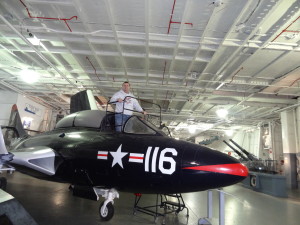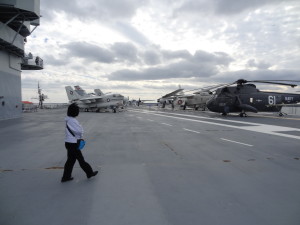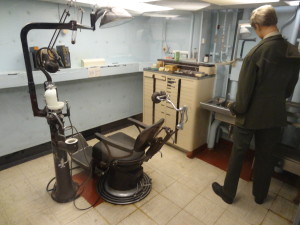On Sunday, just two days ago, on the way back from another investment boot camp in Jacksonville, Florida, David and I stopped in to see the USS Yorktown.
 As students of WWII and, in particular, the history between the United States of America and Japan, both of us were very much looking forward to this visit. As expected, it was well worth dedicating the time for this purpose. What we did not realize until arrival was how huge Patriots’ Point in South Carolina was. In fact, the USS Yorktown is one of many U.S. military points of interest there. The membership fee of $75 enables us to visit as often as we want within one year; regular entrance fee is $18 each or $15 for seniors and other discounts for military personnel.
As students of WWII and, in particular, the history between the United States of America and Japan, both of us were very much looking forward to this visit. As expected, it was well worth dedicating the time for this purpose. What we did not realize until arrival was how huge Patriots’ Point in South Carolina was. In fact, the USS Yorktown is one of many U.S. military points of interest there. The membership fee of $75 enables us to visit as often as we want within one year; regular entrance fee is $18 each or $15 for seniors and other discounts for military personnel.
The ship itself is so big that it is like a floating city. The “Visitors Guide and Map” is divided into five tours plus Tour 6 for the Charleston Naval Shipyard Museum. Going at a very leisurely pace, allowing plenty of time for rest, we were able to complete Tours 1 through 3. Had we started the tours at 9 a.m. just as it opened, we would probably have been able to complete all six tours within one day.
The primary reason I wanted to visit the USS Yorktown was because its name came from the previous one that was sunk by Japanese during WWII. I learned that there were actually four ships with the same name sake:
- The original ship that was named the USS Yorktown was built in 1839 and commissioned in 1840. She operated primarily on the U.S. Pacific coast, protecting the American whaling fleet. In 1850, it struck an uncharted reef in the Cape Verde Islands, 400 miles off the western coast of Africa, broke up, and was lost.
- The second one was built in 1887, launched in 1888, and commissioned in 1889. It was dispatched in 1891 to Chile to protect the Americans. From 1894 to 1897, its principal ports of call were the coasts of Japan and China. After having been decommissioned and re-commissioned several times, it was finally taken out of service in 1919 and sold for scrap.
- The third one, an aircraft carrier, was commissioned in the United States Navy in 1937. After arriving in the Pacific in January 1942, its first assignment was to escort the convoy that was transporting the Marines to American Samoa. It was sunk during the Battle of Midway on June 2, 1942 as Lieutenant Joichi Tomonaga of the Imperial Japanese Navy crashed onto the carrier on his third bombing attack, crippling her functional ability.
- The fourth one that we visited at Patriots Point was built and launched in 1943; it saw combat during WWII, Korea, and Vietnam; decommissioned in 1970; and became a floating museum in 1975.
As soon as I descended into the belly of this ship, I felt uneasy – despite the fact that David was by my side at all times except, of course, in the ladies’ room. This sensation could have been due to one or more of a few different possibilities. First, there were few other visitors on board – giving me a sense of isolation in an unfamiliar and cramped environment. Second, I could have been suffering from a mild form of claustrophobia which, up until this moment, I never thought I had. (I have even visited inside the engine room of a cruise ship and never experienced anything like this before.) Lastly, while I will never know for sure, the spirits of those who lived, fought, and suffered inside this ship may have caused disturbances. Regardless of the exact cause for my uneasiness, right there and then, I knew that I did not need to come back for the evening “USS Yorktown Ghost Tours.”
Despite such anxious moments, the likes of which I have never experienced, I still look forward to completing the rest of the tours (Tours 4, 5, and 6) during our next visit.
One disappointment during this visit was that the mess hall, where they usually serve lunch, was closed for the winter season. The website did not mention it – so we will call the museum in advance and schedule our visit accordingly so as to make sure to enjoy it next time. I am curious to see if I will feel more comfortable inside the ship the second time around. We also intend to visit Fort Sumter, where the Civil War began in 1861, which also is at Patriots Point. History is fascinating!
Wishing you and your loved ones Happy Holidays!
Footnote: Heading north on I-77 from South Carolina into North Carolina, we happened to come upon the exit for the Billy Graham Library. The next time we drive back up north from Florida, we will make it a point to stop there as well. Reverend Billy Graham helped heal millions of people around the world from depths of despair. He prayed with every President of the United States of America since Harry S. Truman. I am particularly interested in his message because his name keeps coming up when I read books written by various individuals who experienced WWII. Just last month, on November 7, 2013, he celebrated his 95th birthday. Thank goodness for the modern technology, which enables me to view and listen to his many recorded messages.




